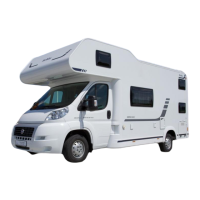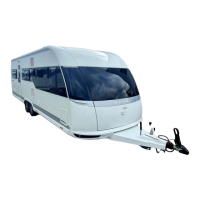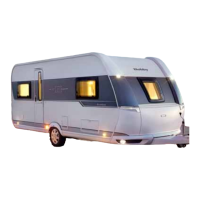
Do you have a question about the Hobby 750 UML Landhaus and is the answer not in the manual?
| Brand | Hobby |
|---|---|
| Model | 750 UML Landhaus |
| Category | Motorhomes |
| Language | English |
Provides general information about the camper, its development, safety regulations, and technical condition.
Guidance on familiarizing with the handbook and securing guarantee rights for built-in appliances.
Covers important safety instructions for people and property, including ventilation and maintenance.
Highlights driver responsibility for vehicle condition and safety labels that must not be removed.
Rules for loading the camper, emphasizing even weight distribution, securing heavy objects, and checking total weight.
Advice on shunting, highlighting blind spots and the use of a guide for difficult parking spots.
Recommendations for taking a test drive and rules for driving, including speed adjustment and side winds.
Guidance on driving in reverse, noting camper tilting and the use of a guide.
Rules for driving around curves, emphasizing wider radius and camper's tendency to sheer out.
Details on the first aid kit and warning triangle, their accessibility, and proper usage in emergencies.
Recommendations for vests and fire extinguishers, including their importance for safety.
Safety measures to prevent fires, including never leaving children unattended and keeping escape routes clear.
Steps to take when fighting a fire, including evacuation, shutting off supplies, and calling the fire department.
Details maximum speed limits and conditions for travelling at 100 km/h, including vehicle requirements and tire age.
Rules for selecting a parking place and securing the vehicle, including brake and stanchion use.
Guidance on redirecting electrical devices and emptying water installation to prevent damage.
Information on frame parts, axles, no modifications, and maintenance by a HOBBY dealer.
Rules for greasing and oiling undercarriage parts, including frequency and specific components.
Steps for hitching and unhitching the camper, including support wheel use for higher drawbar loads.
Procedure for hitching the tension ball coupler onto the coupling ball of the base vehicle.
Guidance on inspecting the hitch to ensure it is properly attached and closed for safety.
Steps to activate the stabilization system, including lever movement and contact pressure on the coupling ball.
Instructions for shutting off the system and unhitching the trailer, including safety precautions.
Guidelines for maintaining the coupling ball, ensuring it is clean, stable, and free of grease for proper function.
Instructions for cleaning the tension ball coupler's friction linings and greasing movable parts for longevity.
Information on changing the front friction lining of the tension ball coupler due to wear.
Information on registering the camper, required documents, and applying for a '100 km/h' sticker.
Details the mandatory general inspection every two years and the documents required for the inspection.
Location and importance of the Vehicle ID number (FIN) and the vehicle's name plate.
Guidelines for using designated tires, checking tread wear, condition, and driving on new tires.
Rules for checking tire pressure regularly, adjusting for cold/warm tires, and the risks of low tire pressure.
Important warnings about using the correct jack, its purpose, and securing the vehicle during tire changes.
Step-by-step instructions for changing a wheel, including jacking, removing screws, and attaching the spare tire.
Rules for proper ventilation and de-aerating of the vehicle for comfort and to prevent suffocation.
Instructions for opening/closing entry doors and service flaps, emphasizing secure latching.
Procedures for operating gas bottle container, toilet flap, and exterior electrical socket covers.
General safety tips for electrical installations, including battery types, authorized specialists, and cable usage.
Explanation of push-button functions on the service panel, including on/off switches and dimmer functions for lights.
Details on the main switch's function for consumers connected to the system, including memory reset.
Description of push-button functions on the secondary panel in the sleeping area, including spotlights and ceiling lamps.
Description of push-button functions on the secondary panel in the washroom, including spotlights and lamps.
Details on obtaining electricity via 230V mains connection, base vehicle, or auxiliary battery.
Explains 12V operation via the base vehicle battery, switching off during stops, and refrigerator function.
Instructions for operating the Truma-Vent fan unit with 12V, including manual adjustment and automatic operation.
Illustrates the 12V electrical installation for the vehicle, showing exterior lights and wiring.
Details the contacts of the 13-poled 'Jäger' outlet and their corresponding circuits.
Details spotlights, corner lamps, and indirect lighting in the suite and kitchen areas.
Describes window lighting, dimmable ceiling lamps, and cupboard lamps.
Describes indirect lighting above windows and the dimmable suite ceiling lamp.
Shows lamps located inside the clothes cupboard.
Instructions for opening and closing furniture flaps with handles, with a safety warning about securing them.
Details on the bathroom door handle and the clothes cupboard door knob.
Instructions for opening and shutting hinged windows, with a safety note about windows by children's beds.
Details on integrated shades and insect screens in the window frame, and how to shut and open them.
Description of the panorama thermal roof bonnet and safety instructions for its use.
Details the thermal roof bonnet in the bedroom and operating instructions for opening and closing.
Explanation of how the shade is infinitely variable and how to adjust it.
Instructions on how to open and close the insect screen using the handle.
Instructions for converting the elevating table model into a bed, including removing cushions and lowering the table.
Explains how water is supplied via an immersion pump, powered by the automobile battery or transformer.
Guidelines for using the immersion pump, including suitability for water, temperature tolerance, and dry runs.
Steps for preparing the toilet, including opening the service flap and removing the water tank extension.
Instructions for operating the toilet, including flushing and closing the valve after use.
Instructions for storing the Thetford toilet for longer periods, including draining water and closing valves.
General rules for warm water supply, advising to use drinking water and consult the user's guide.
Instructions for filling the Truma-Therme using a pre-mixing unit or a mixing faucet.
Procedure for removing water from the Truma-Therme, mixing it to the desired temperature.
Rules for gas facility inspection, installations, modifications, and regulator knobs/valves.
Requirements for gas facility inspection by experts, documentation, and replacement of regulator knobs/hoses.
Rules for using specific regulator knobs, pressure regulators, and their flow rate requirements.
Description of the gas-bottle container, its capacity for two 11kg bottles, and fastening by belts.
Guidelines for securing gas bottles, checking for leaks, accessibility of shutoff valves, and ventilation.
Information on heating element models, installation location, and checks before first use.
Step-by-step instructions for operating the heating element, including ignition and flame control.
Checks before first use of the gas cooker, including opening valves, ventilation, and protective device setup.
Instructions for operating the gas cooker, including opening the cover, setting knobs, and igniting burners.
Notes on operation instructions, installation, circuit diagrams, and effects of modifications on roadworthiness.
List of weights for various accessories, to be considered for determining the camper's full load.
Details fixed maintenance intervals for the camper and devices, including first maintenance and annual checks.
Guidelines for performing maintenance, including first service by a dealer and annual checks.
Rules for cleaning the exterior, advising against frequent washing and use of aggressive cleaners.
Instructions for high-pressure cleaning and advice on waxing surfaces.
Guidelines for polishing surfaces and methods for removing tar, resin, and organic stains.
Emphasizes damage repair and undercarriage coating repair to prevent corrosion.
Instructions for cleaning seat covers, upholstery, curtains, and carpets.
Rules for cleaning PVC surfaces and wooden furniture finishes.
Cleaning the toilet area with neutral soap, avoiding vinegar concentrate and corrosive cleaners.
Cleaning the enamel sink and upkeep rules for accessories.
Information that the camper is suitable for winter operation and recommendations for optimizing it.
Preparation steps including checking for damage, ensuring no water in systems, and protecting metal parts.
General rules for winter operation, including leaving the camper in an enclosed, dry, ventilated space.
Inner furnishing rules for winter, including emptying the refrigerator, ventilating spaces, and managing condensation.
Rules for ventilation and frost protection measures during winter operation.
Rules for the waste water tank in winter, including adding antifreeze and catching waste water outside.
Upkeep rules after winter, including washing the underside, cleaning the exterior, and removing chimney extensions.
Exterior structure rules after winter, including turning stanchions down and preserving painted surfaces.
Rules for containers after winter, including emptying and cleaning water tanks and boilers.
Emphasizes environmentally sound use of the camper, responsible behavior, and parking in designated areas.
Rules for sound use, including not interfering with nature, proper disposal, and acting as a role model.
Guidelines for waste water disposal, emphasizing use of built-in tanks and avoiding greenery or gullies.
Table of tire sizes and their corresponding recommended air pressure in bar.
Table listing weights for various camper models, including empty weight, basic equipment, and load capacity.
Details 12V vehicle lighting, 12V interior lamps, and 230V interior lamps with specifications.











